
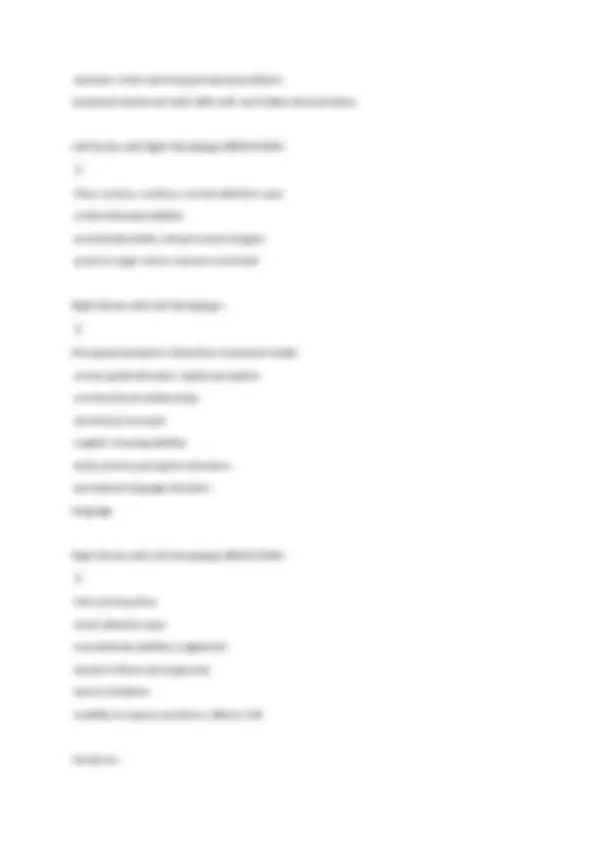
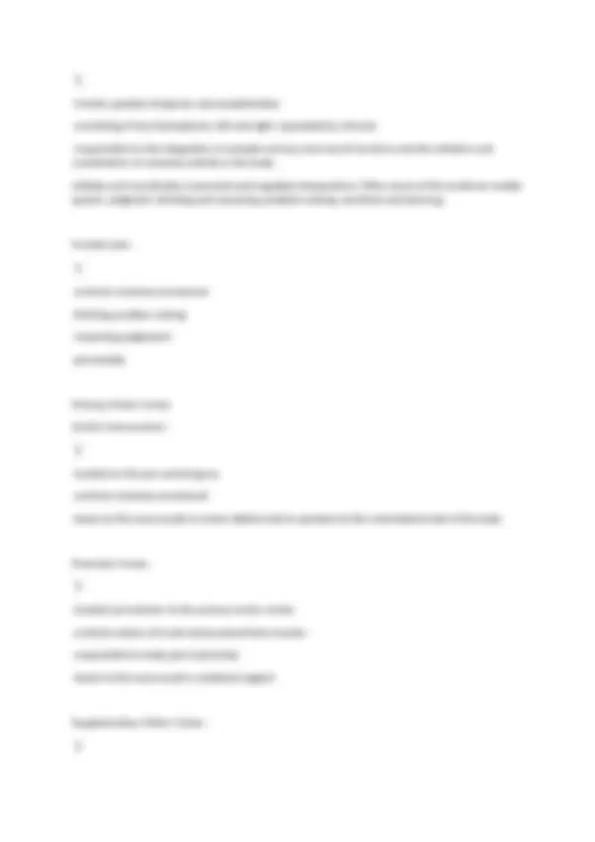
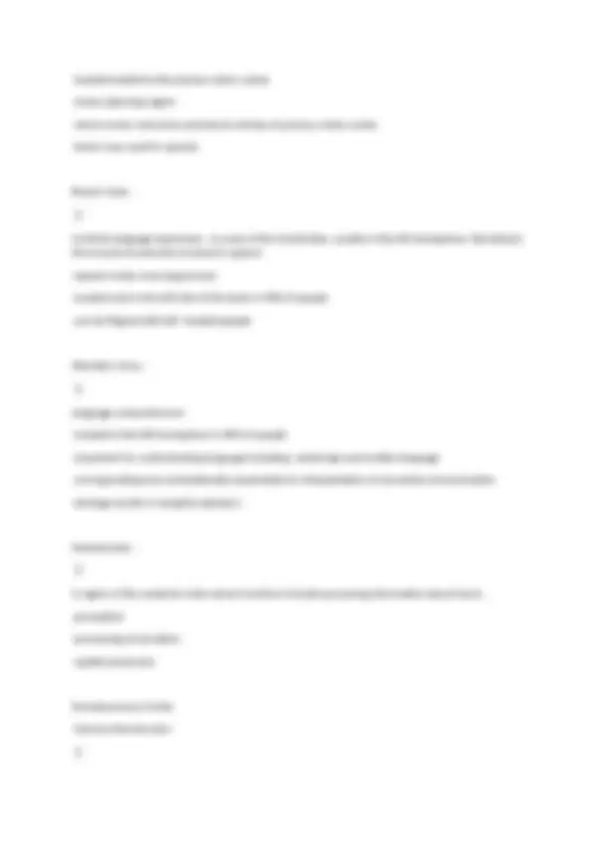
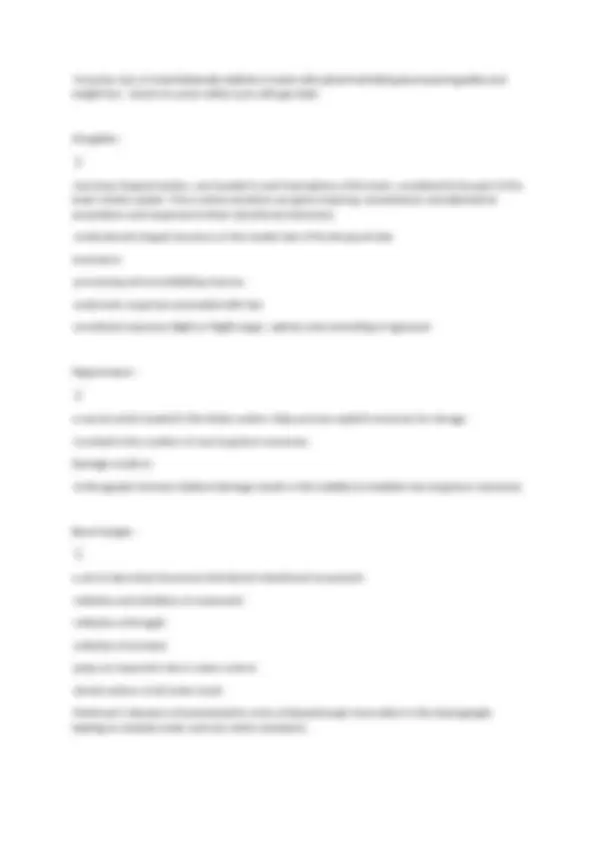
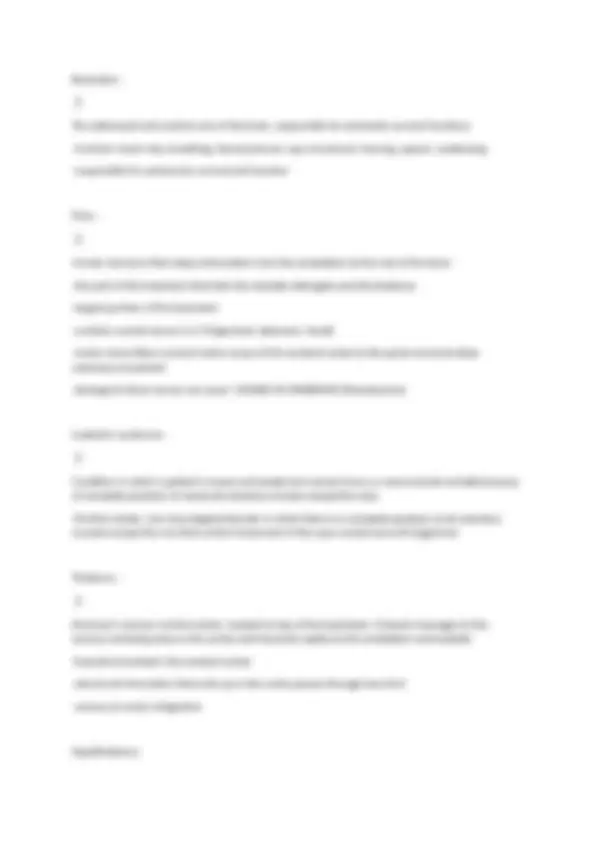
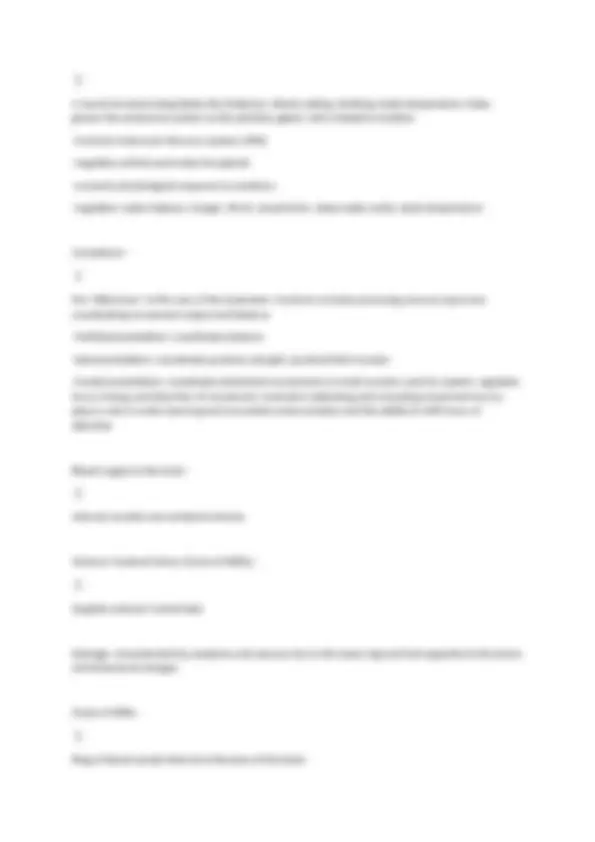
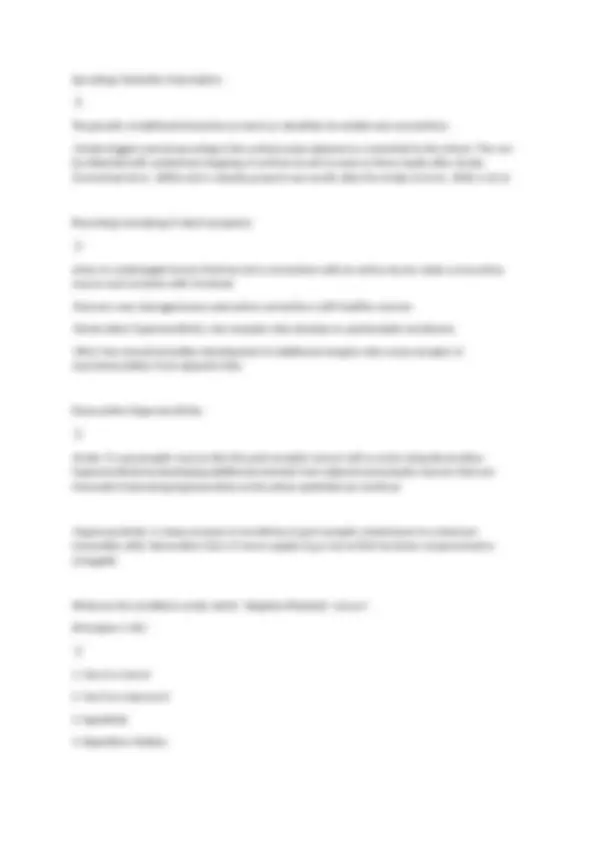
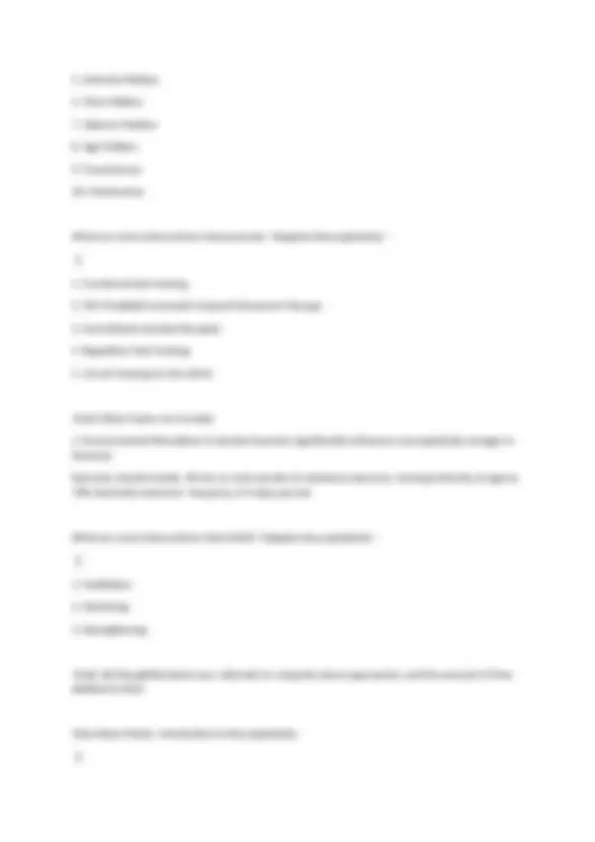
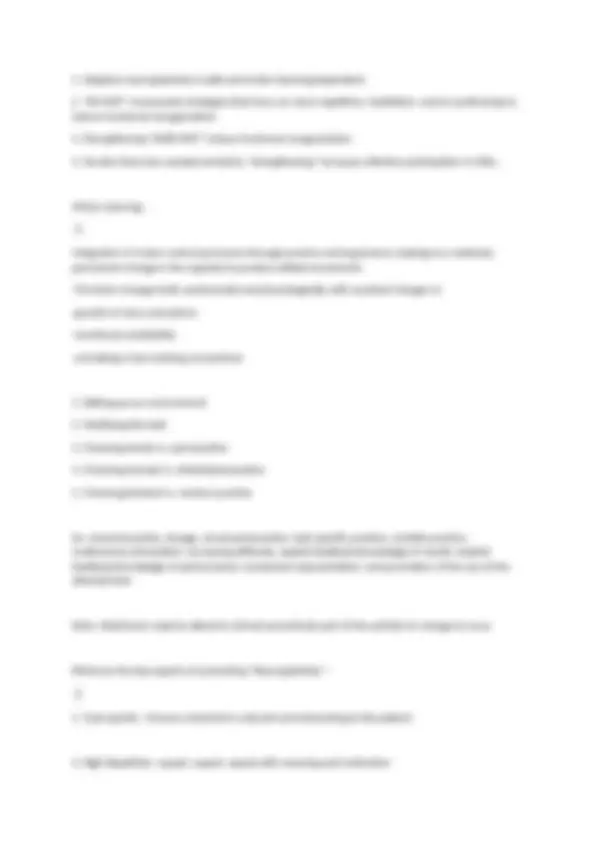
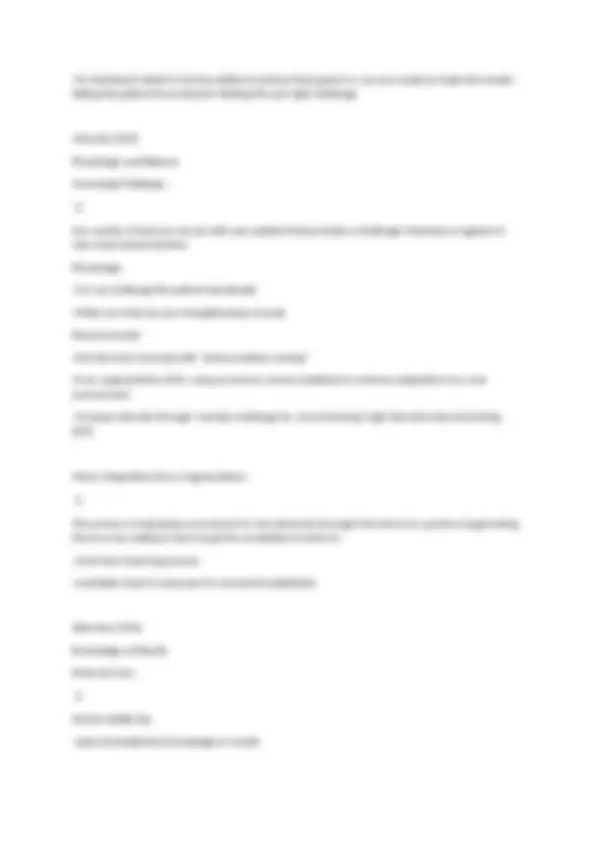
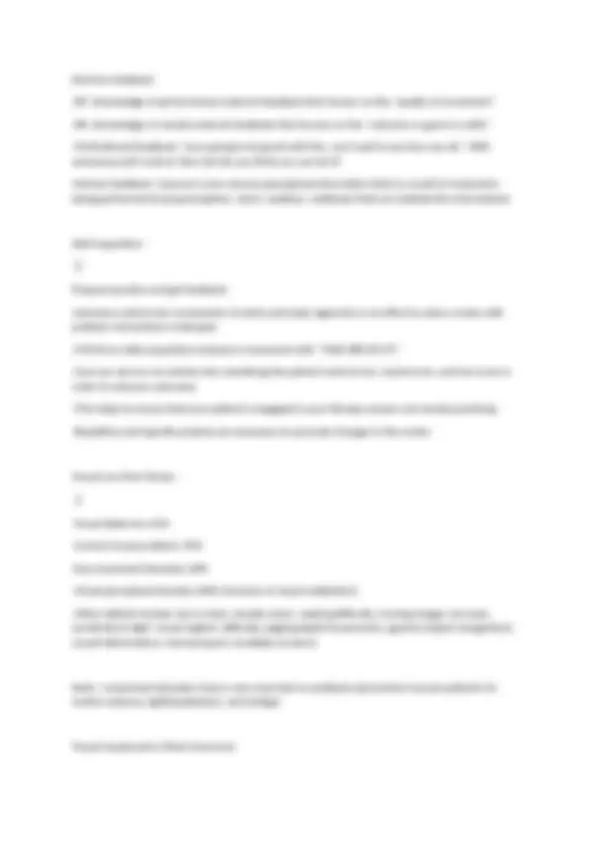
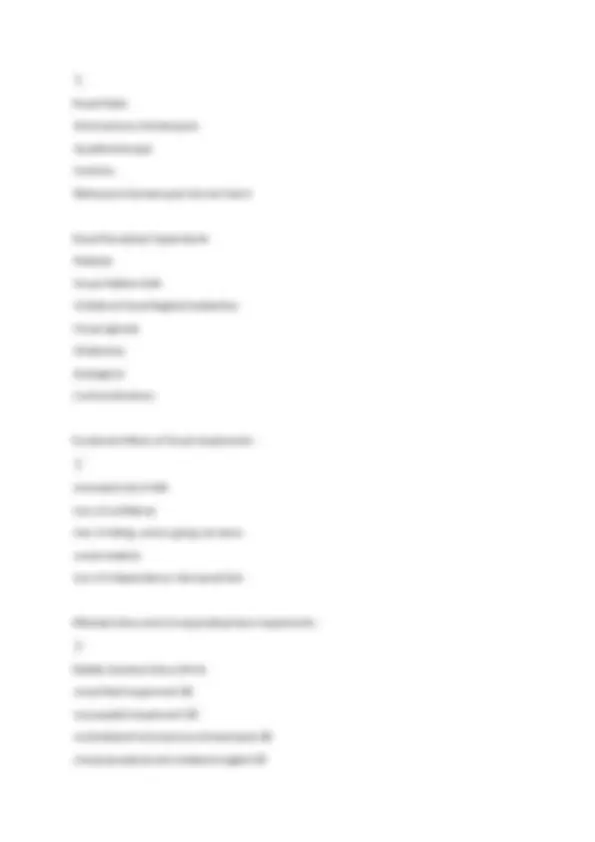
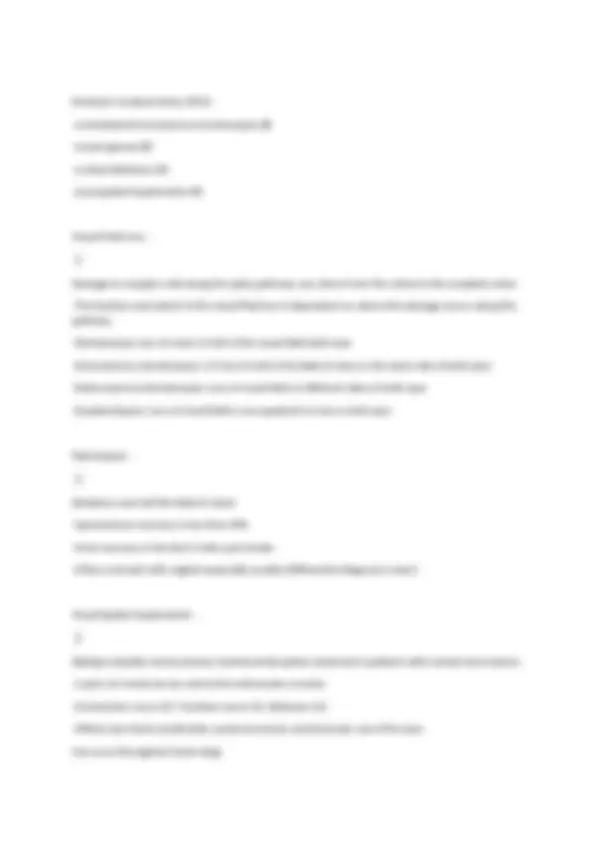
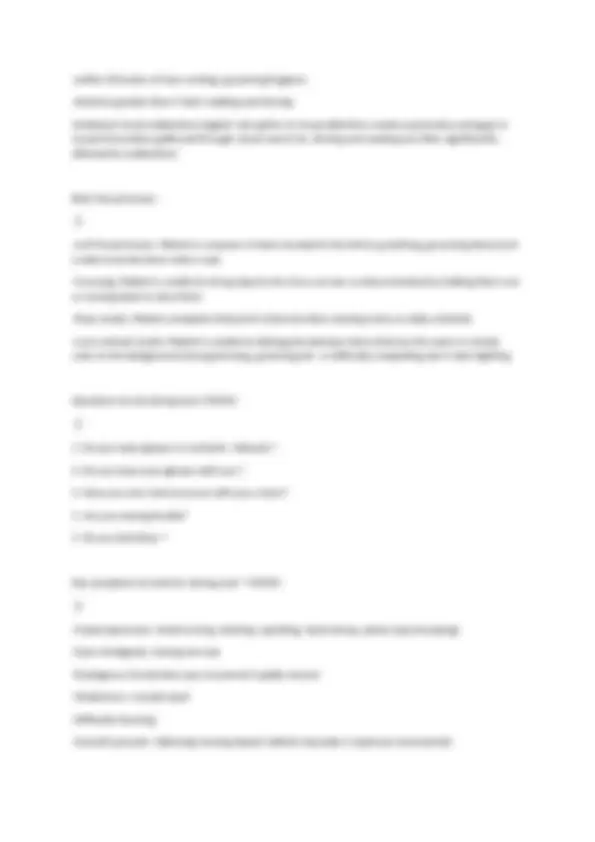
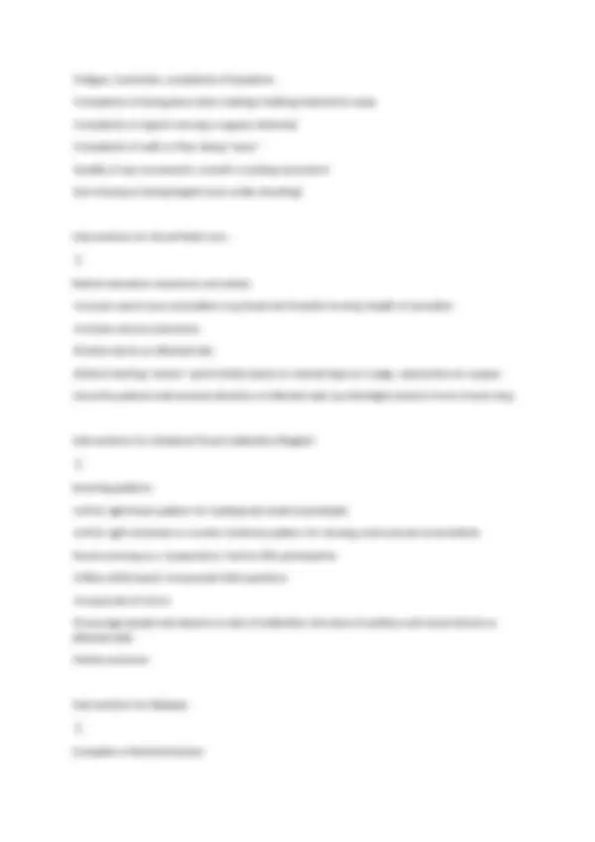
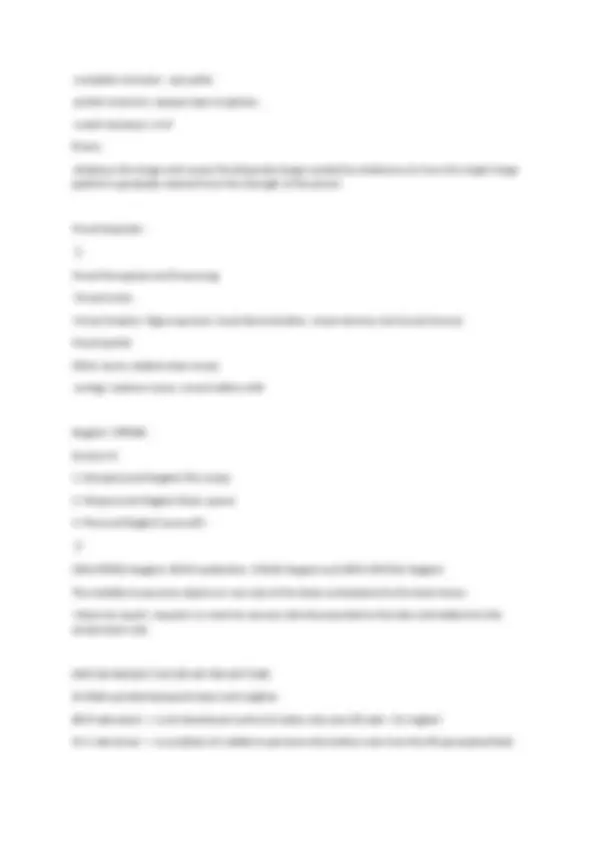
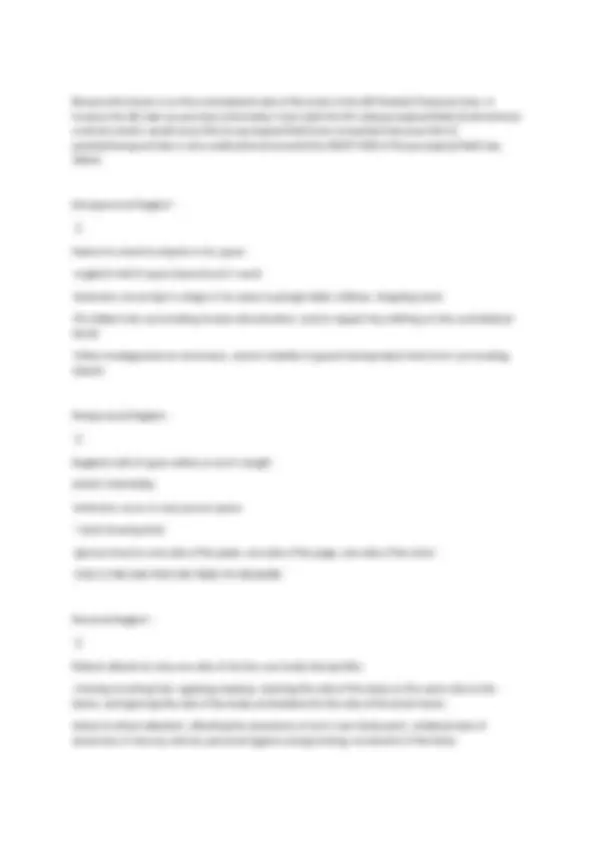
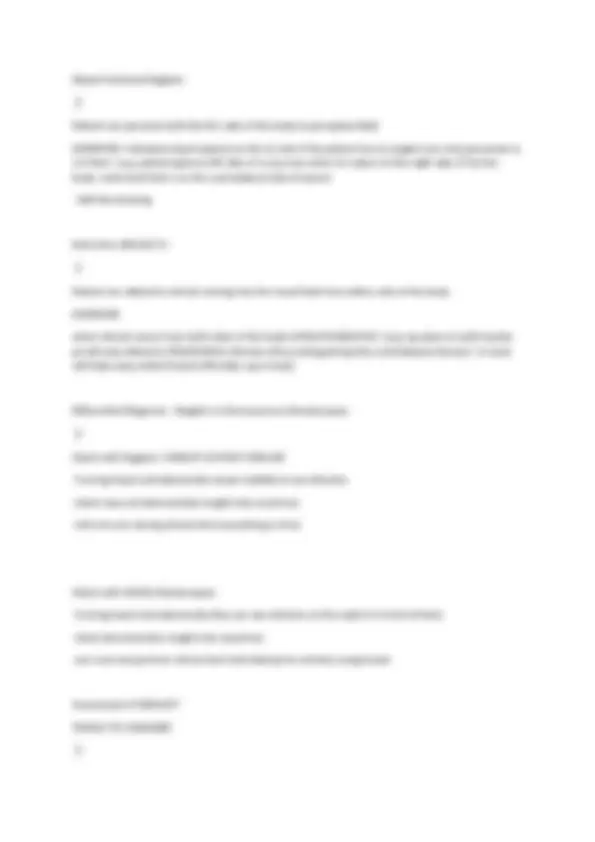
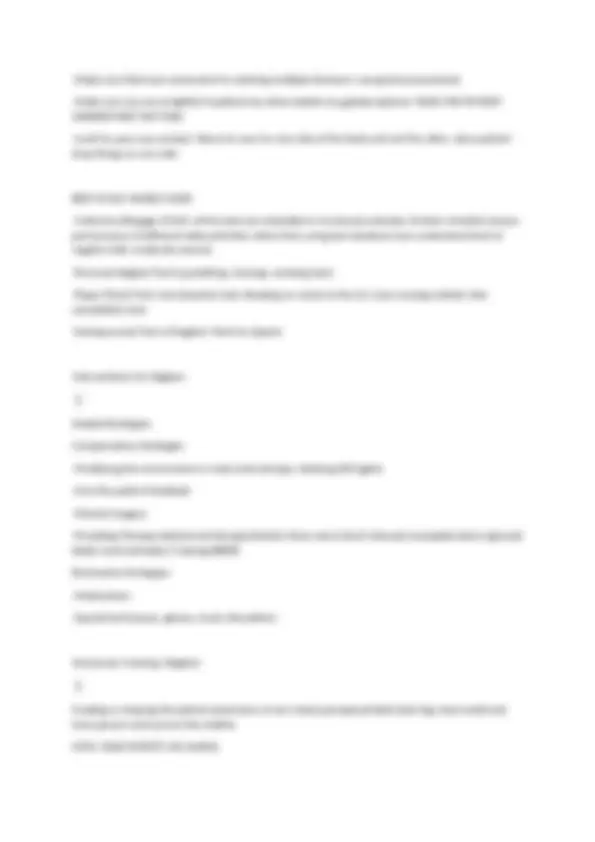
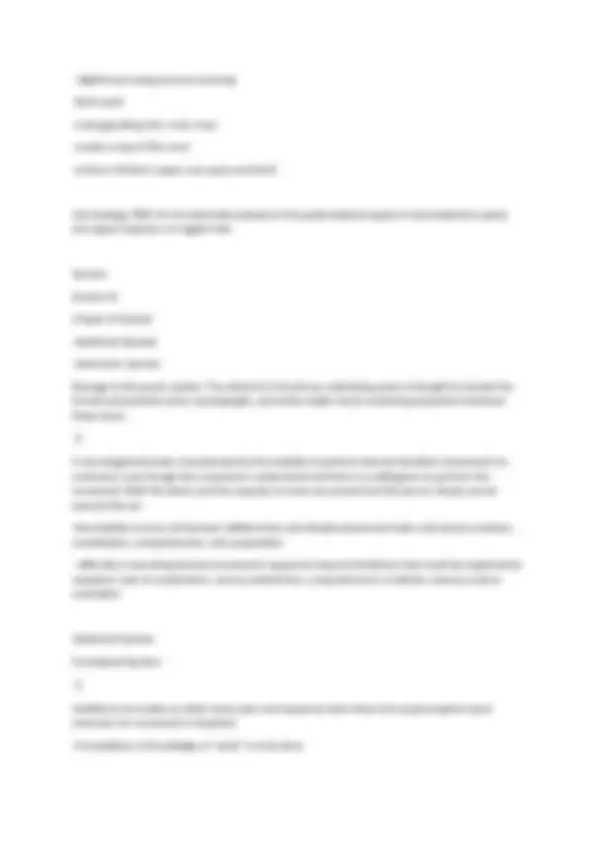
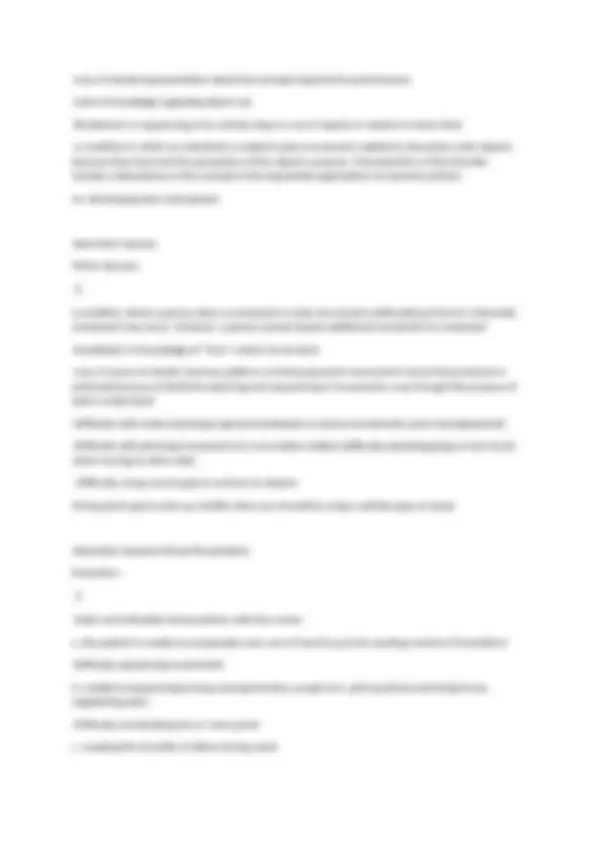
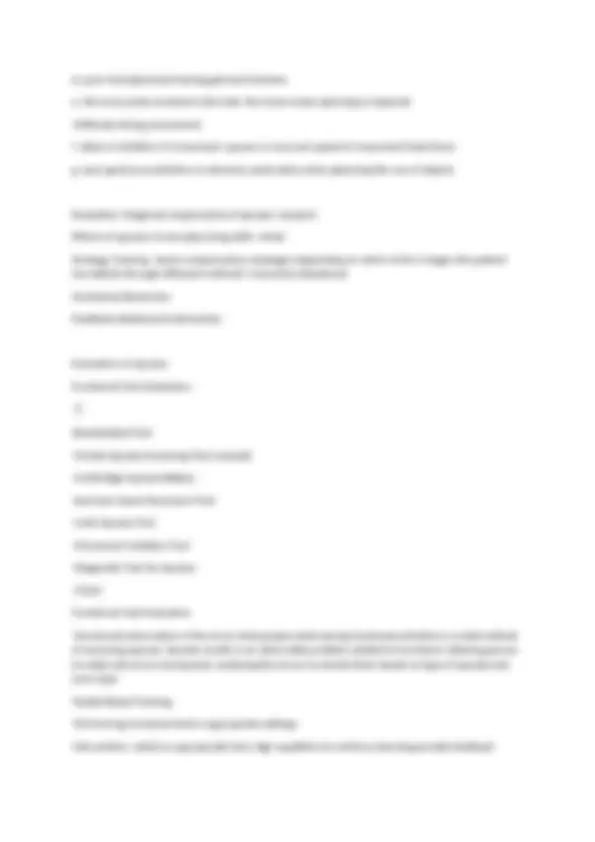
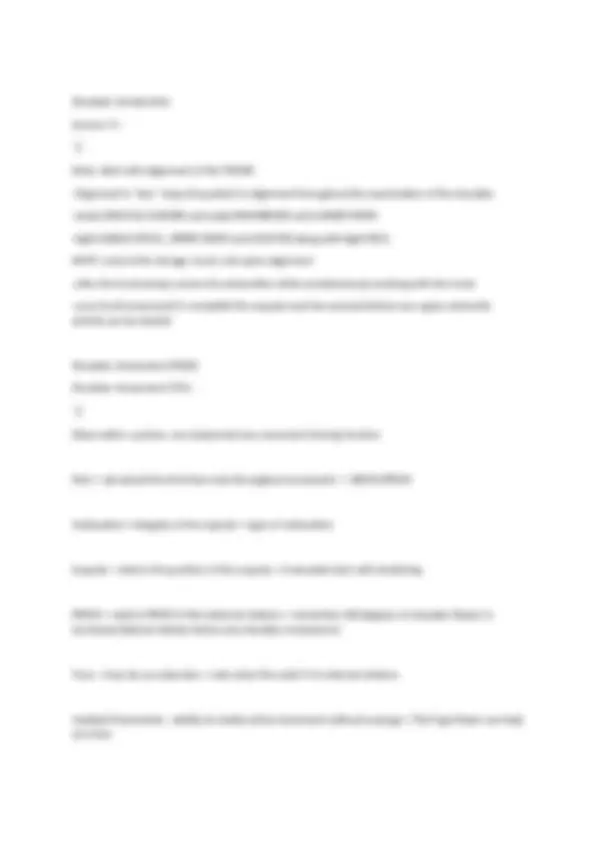
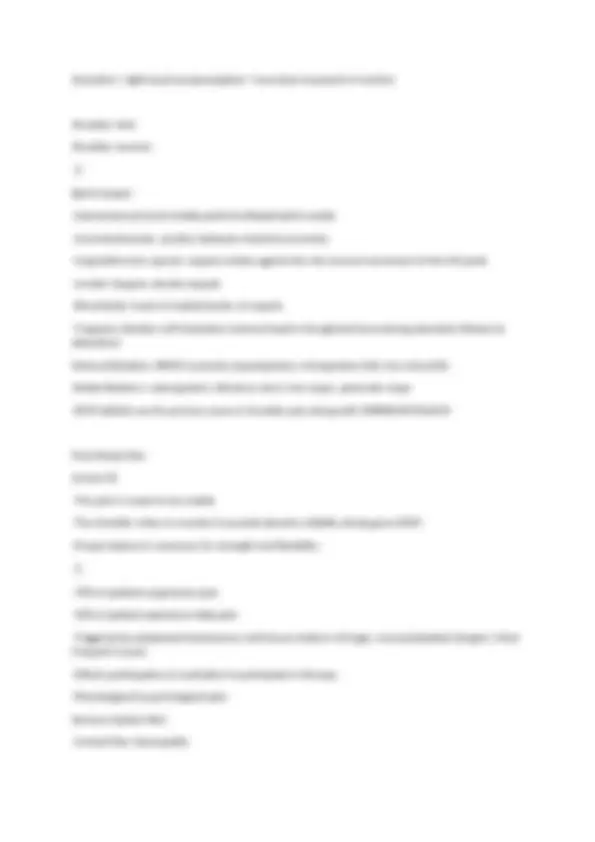
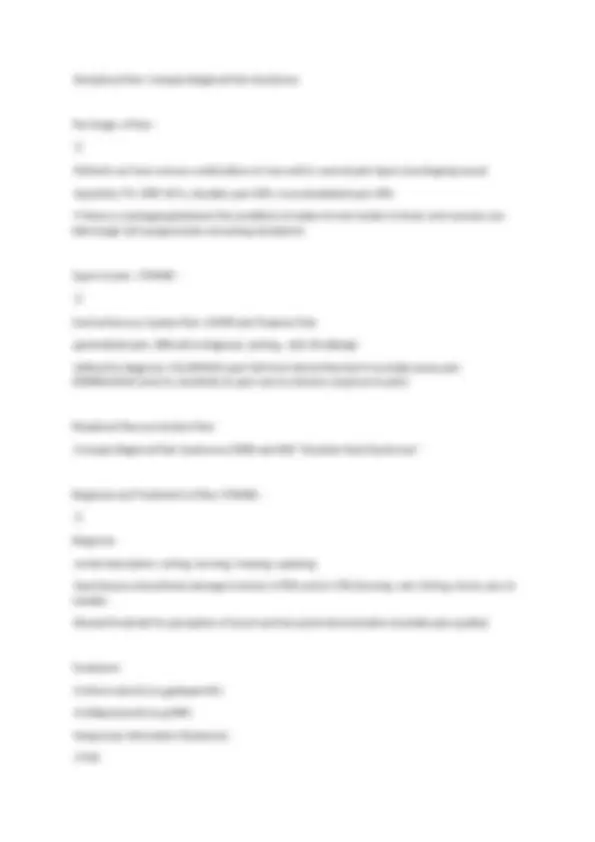
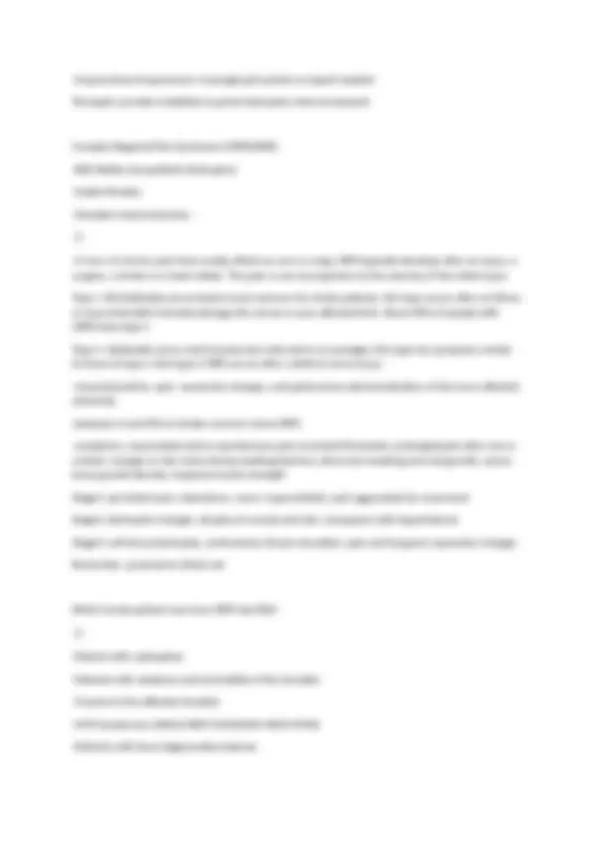
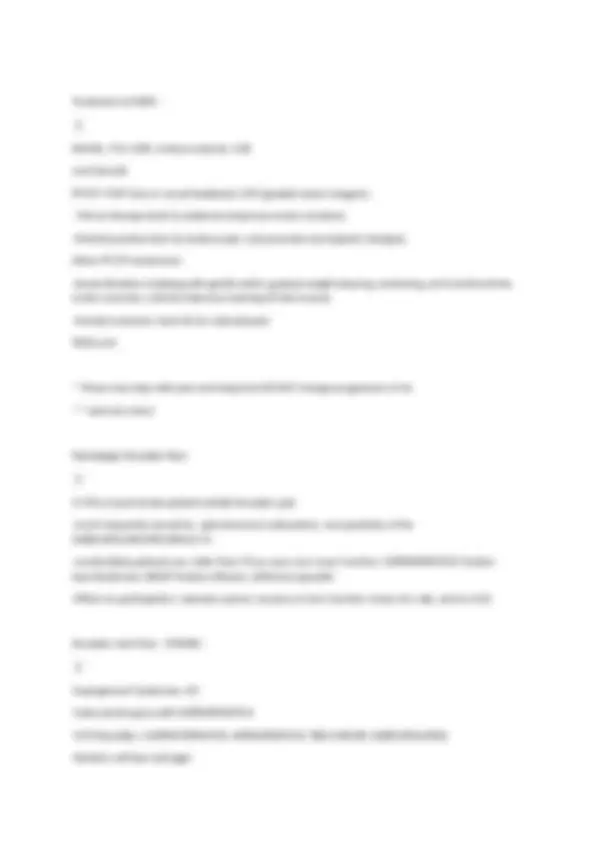
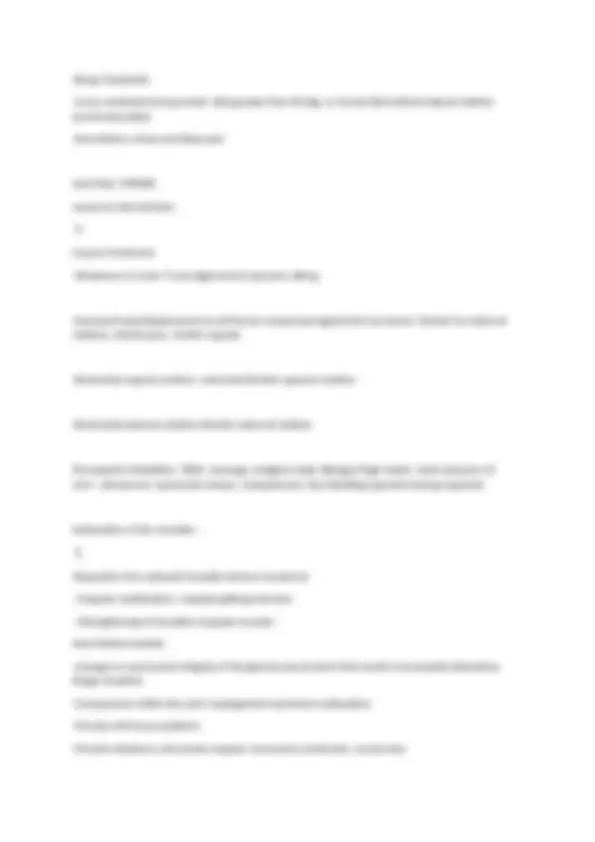
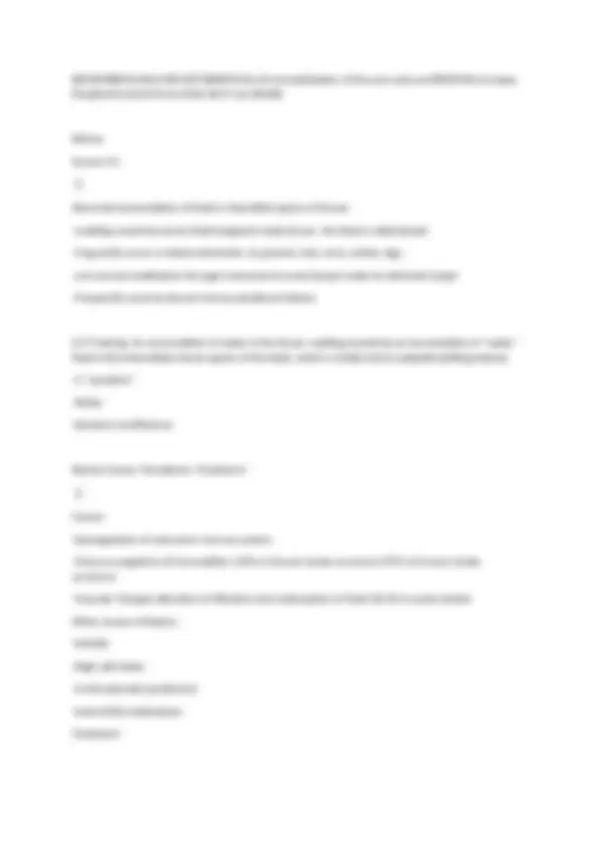
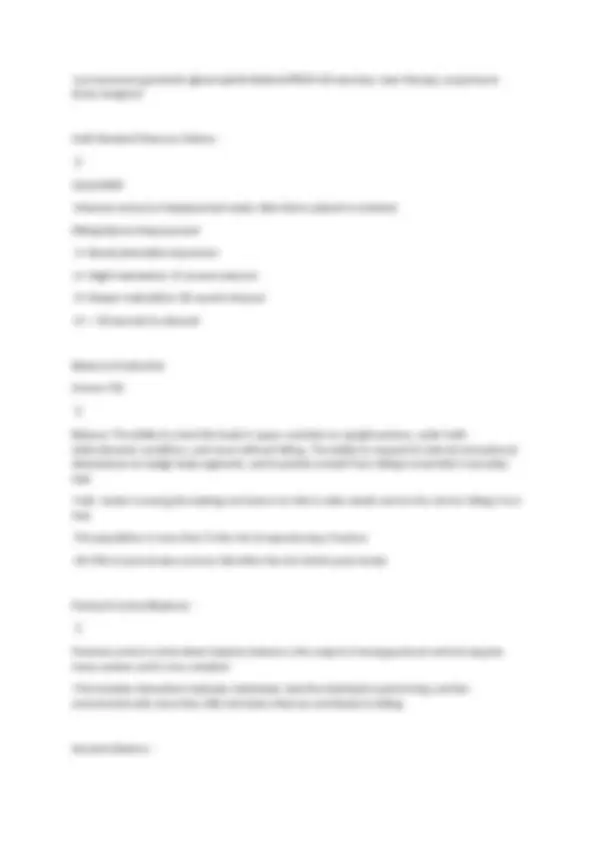
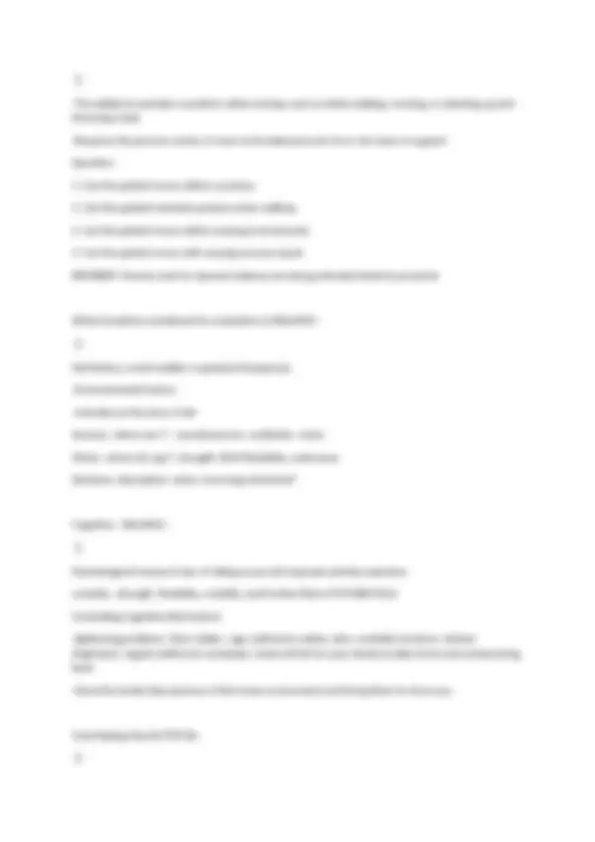
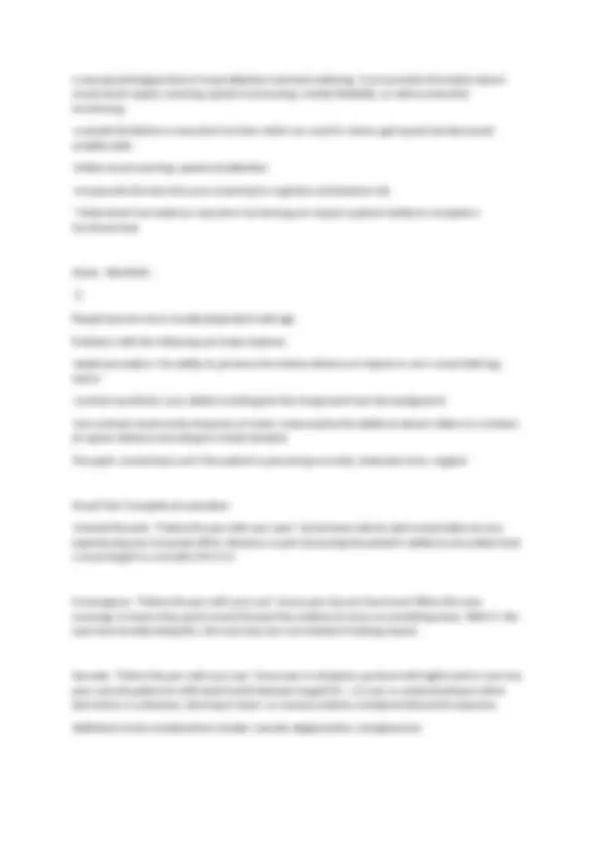
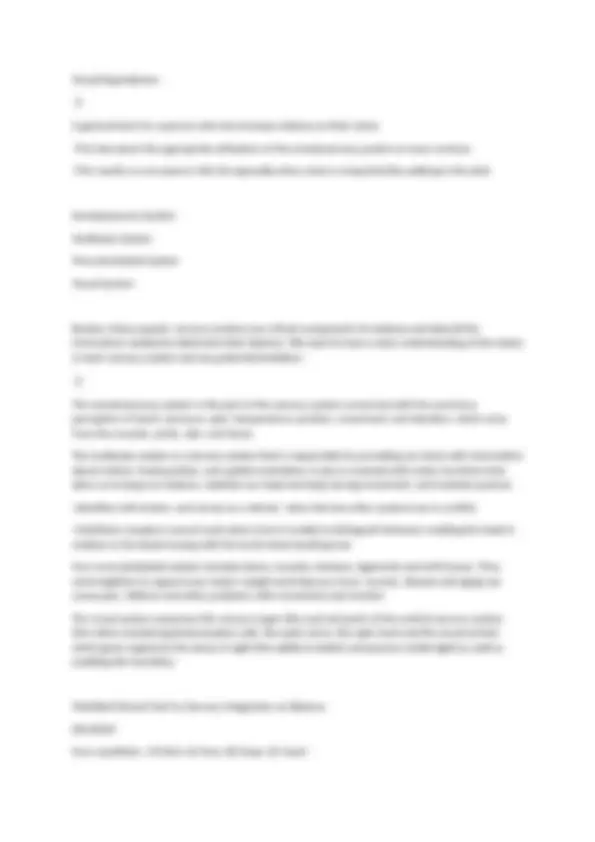
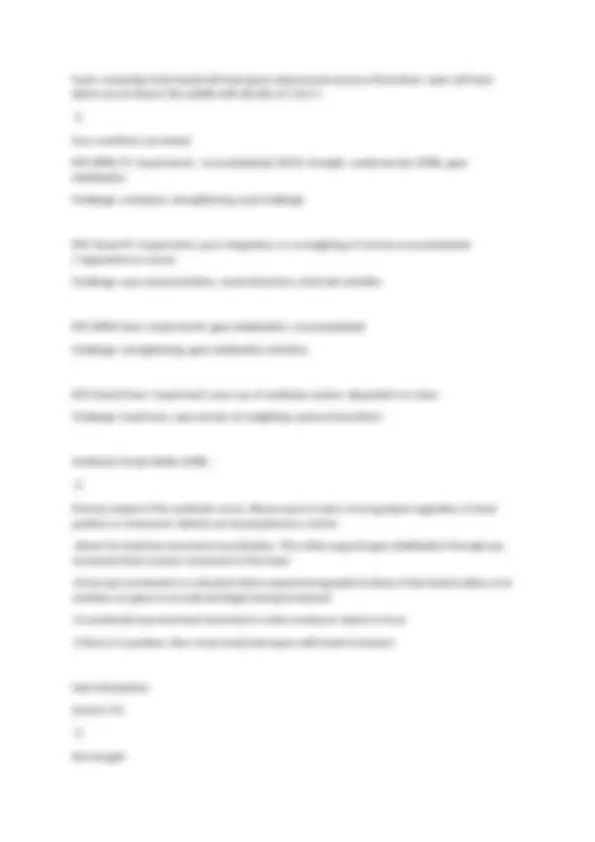
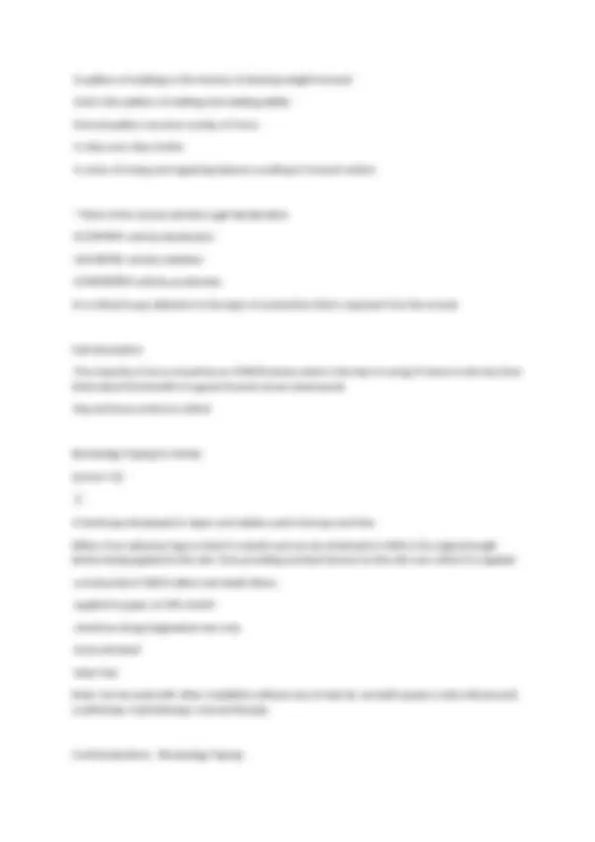
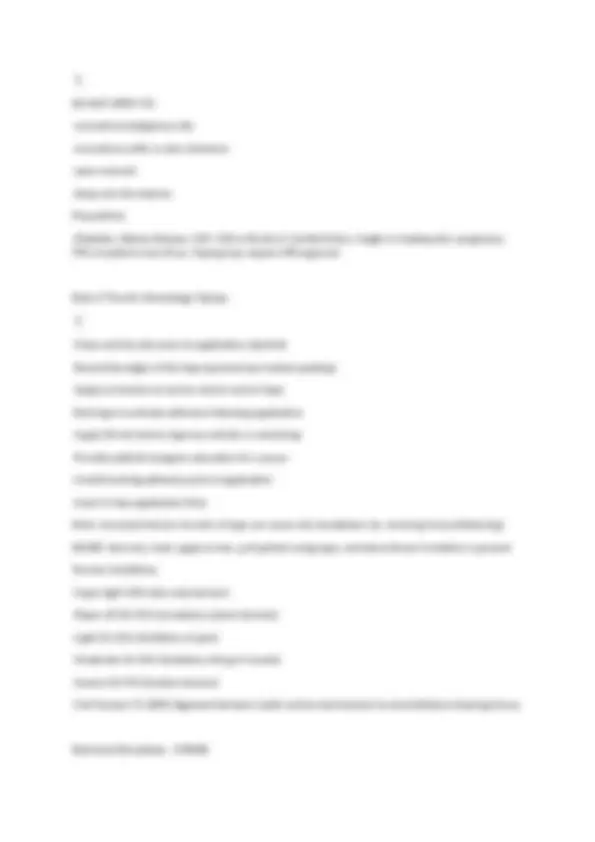
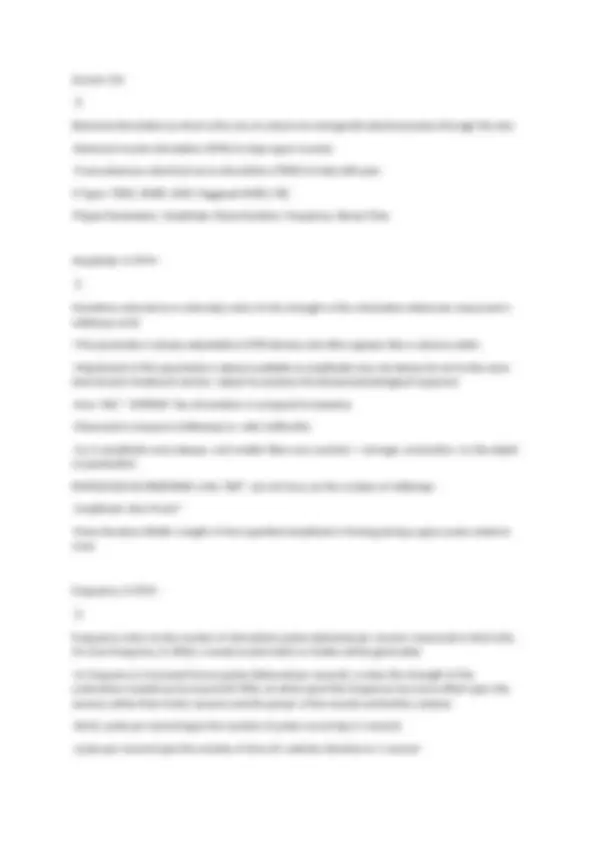
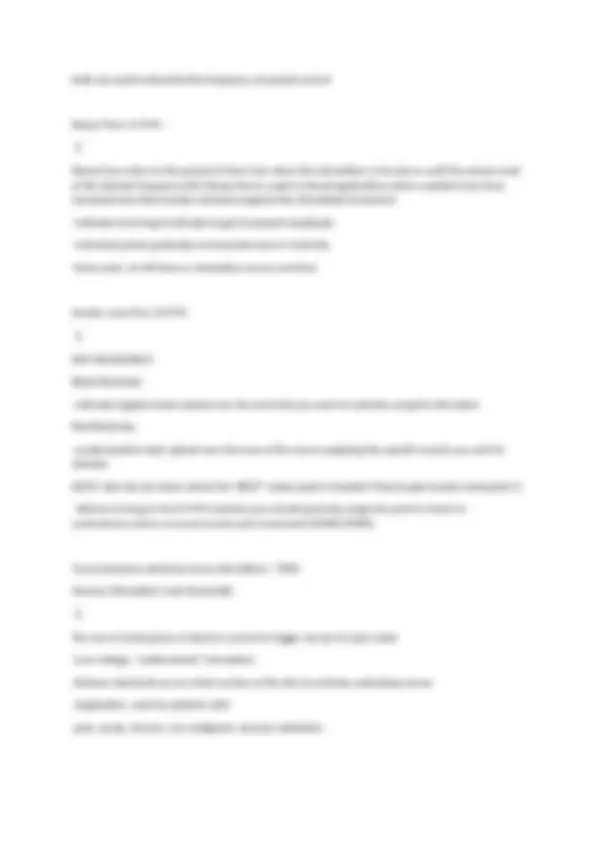
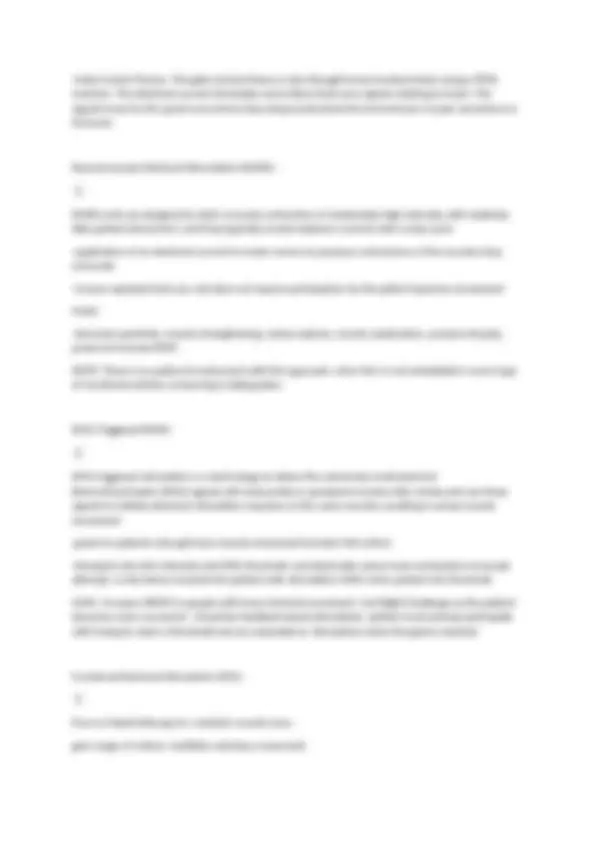
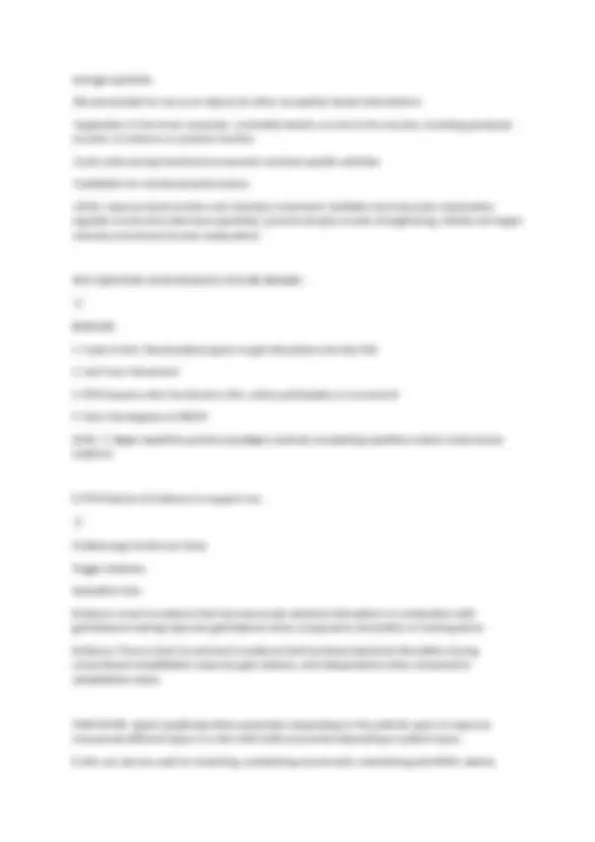
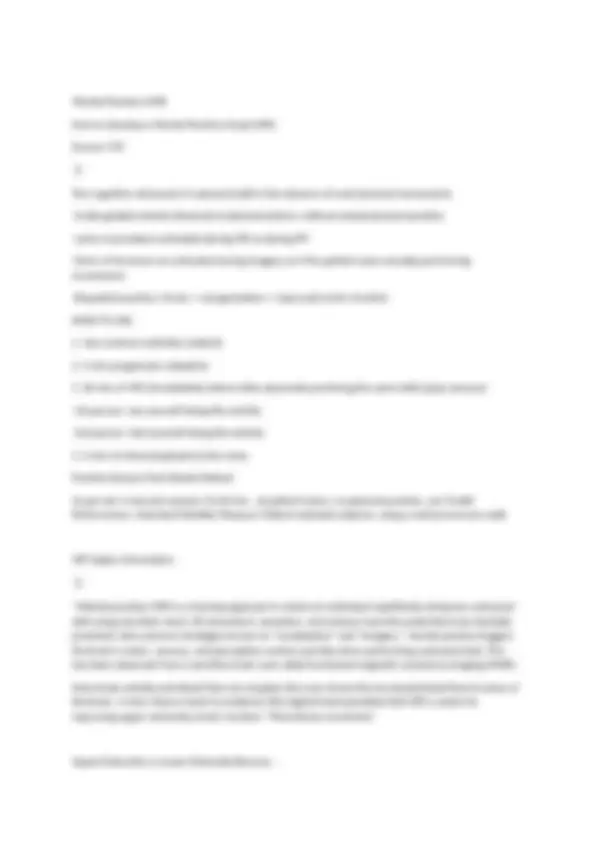
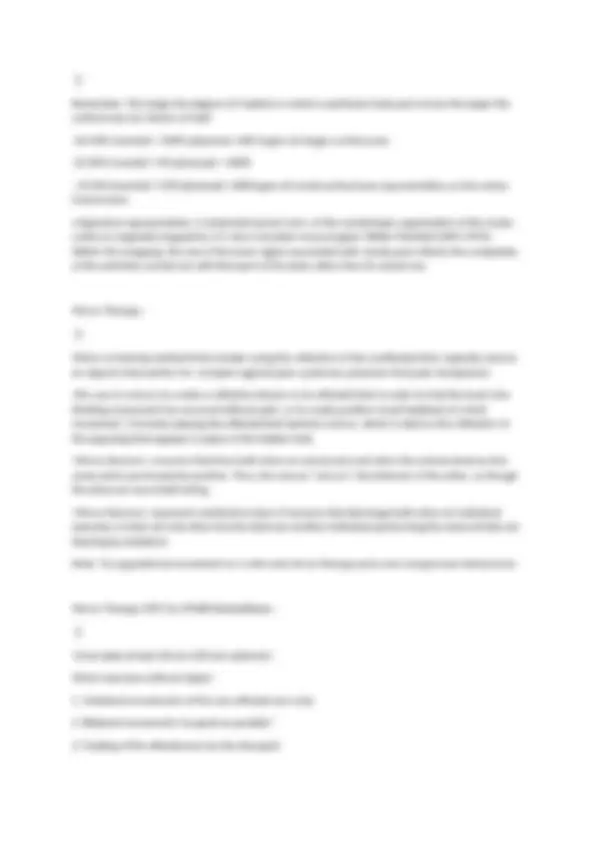
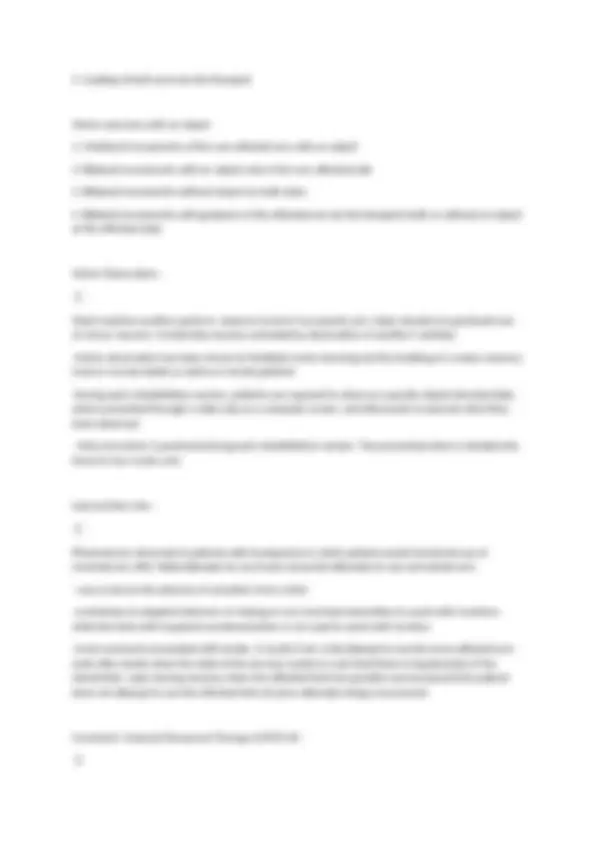
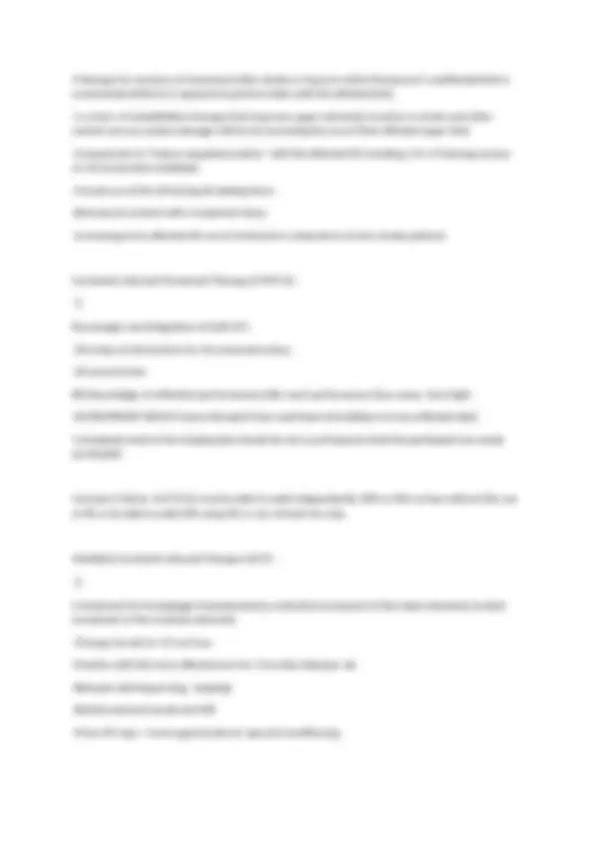
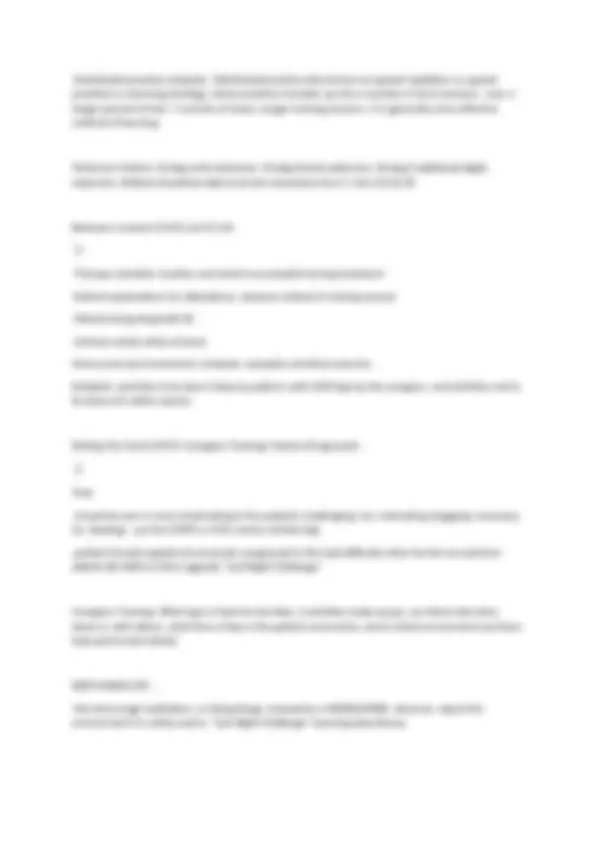
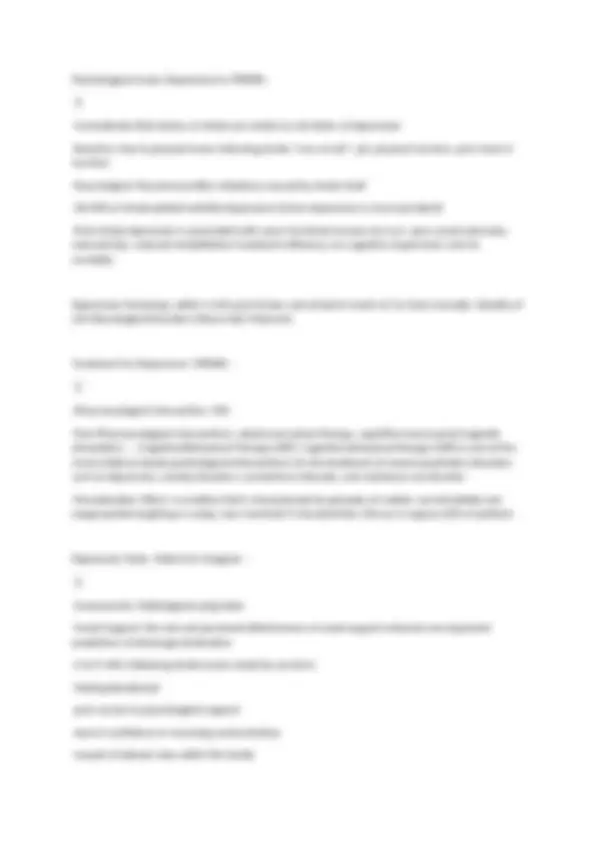
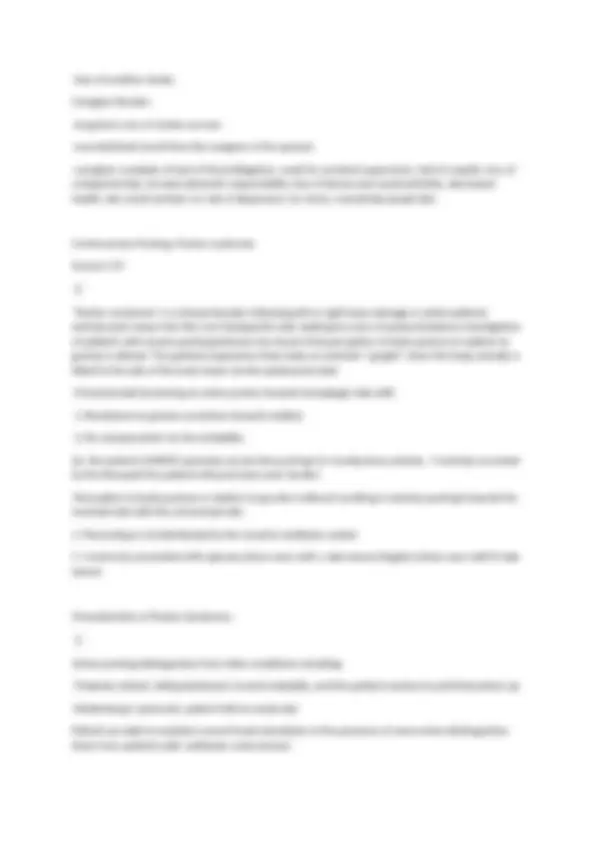
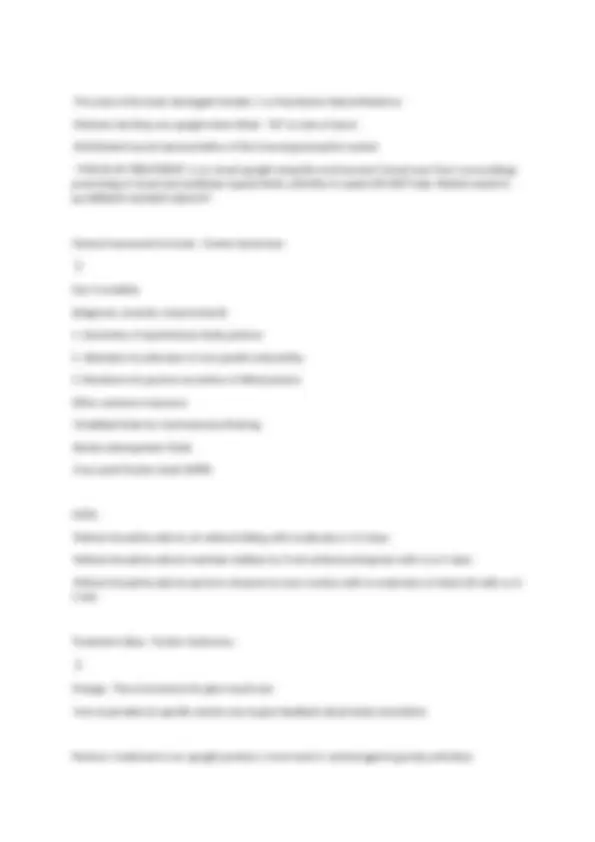
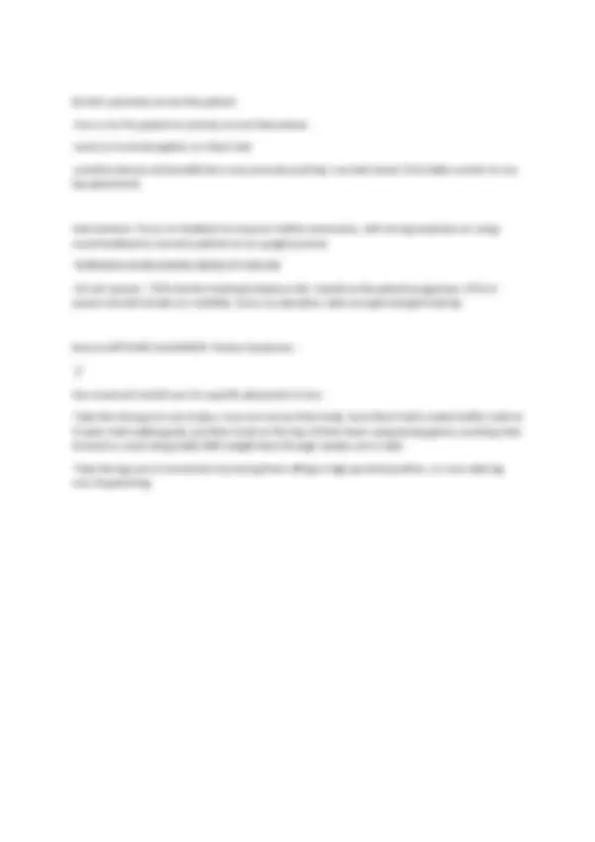


Study with the several resources on Docsity

Earn points by helping other students or get them with a premium plan


Prepare for your exams
Study with the several resources on Docsity

Earn points to download
Earn points by helping other students or get them with a premium plan
Community
Ask the community for help and clear up your study doubts
Discover the best universities in your country according to Docsity users
Free resources
Download our free guides on studying techniques, anxiety management strategies, and thesis advice from Docsity tutors
Certified Stroke Rehabilitation Specialist (CSRS 2025)Latest Study Guide.
Typology: Exams
1 / 57

This page cannot be seen from the preview
Don't miss anything!


















































Types of stroke (Lesson 2) - ✅ Ischemic: 87% -Thrombotic -Embolic -Lacunar Hemorrhagic: 13% -Intracerebral -Subarachnoid Thrombotic Stroke (Ischemic) - ✅ 48% of all strokes -typically occurs during sleep -slow progressive onset of deficits -50% are associated with prior TIA Embolic Stroke (Ischemic) - ✅ 26% of all strokes -typically occurs while awake -sudden, immediate deficits (sometimes seizures) -11% are associated with prior TIA Lucunar Stroke (Ischemic) small vessel disease - ✅
13% of all strokes -small infarct (>15-20 cm) deep in the brain -onset can be gradual or sudden -23% associated with proceeding TIA -often pure sensory or motor symptoms -typically no higher cortical functional involved Intracerebral Hemmorhage (ICH) - ✅ 10% of all strokes -90% happen with the patient is under "no stress" -major cause of "hypertension" -onset may be gradual or sudden -8% are associated with prior TIA -direct correlation with high blood pressure/ hypertension Subarachnoid Hemorrhage (SAH) - ✅ 3% of all stroke -occurs often during strenuous activity -cause: rupture aneurysms and vascular malformations -sudden onset -7% are associated with preceding TIA Left Stroke with Right Hemiplegia - ✅ -Language/Perceptual problems -expressive aphasia -receptive aphasia -global aphasia -alexia, agraphia , acalculia
-frontal, parietal, temporal, and occipital lobes -consisting of two hemispheres, left and right, separated by a fissure -responsible for the integration of complex sensory and neural functions and the initiation and coordination of voluntary activity in the body. initiates and coordinates movement and regulates temperature. Other areas of the cerebrum enable speech, judgment, thinking and reasoning, problem-solving, emotions and learning. Frontal Lobe - ✅ -controls voluntary movement -thinking problem solving -reasoning judgement -personality Primary Motor Cortex (motor homunculus) - ✅ -located on the pre-central gyrus -controls voluntary movement -lesion to this area results in motor deficits and/or paralysis to the contralateral side of the body Premotor Cortex - ✅ -located just anterior to the primary motor cortex -controls actions of trunk and proximal limb muscles -responsible for body part ownership -lesion to this area result in unilateral neglect Supplementary Motor Cortex - ✅
-located medial to the primary motor cortex -motor planning region -stores motor memories and directs activity of primary motor cortex -lesion may result in apraxia Broca's Area - ✅ Controls language expression - an area of the frontal lobe, usually in the left hemisphere, that directs the muscle movements involved in speech. -Speech motor area (expressive) -located only in the left side of the brain in 90% of people -can be flipped with left -handed people Wernike's Area - ✅ language comprehension -located in the left hemisphere in 90% of people -important for understanding language including: verbal sign and written language -corresponding area contralaterally responsible for interpretation of nonverbal communication -damage results in receptive aphasia ( Parietal Lobe - ✅ A region of the cerebral cortex whose functions include processing information about touch. -perception -processing of sensation -spatial awareness Somatosensory Cortex -Sensory Homunculus - ✅
-qudrantanopia: anopia affecting a quarter of the field of vision. (describes defects confined mostly to approximately one-fourth of an eye's visual space) Visual Association Area (Occipital Lobe) - ✅ Located anterior to the primary visual cortex Responsible for: -interpretation of visual stimuli (spatial perception & recognition of faces) Damage results in: -visual agnosia: the patient can see the item however they can not recognize it Temporal Lobe - ✅ An area on each hemisphere of the cerebral cortex near the temples that is the primary receiving area for auditory information -limbic system (responsible for emotion & memory) -auditory system -olfactory system -facial recognition Aphasia (3 types) - ✅ A language disorder that affects a person's ability to communicate. -Expressive aphasia - you know what you want to say, but you have trouble saying or writing what you mean. -Receptive aphasia - you hear the voice or see the print, but you can't make sense of the words. -Global aphasia - you can't speak, understand speech, read, or write Primary Olfactory Cortex - ✅ responsible for awareness and identification of an odor Damage results in:
-Anosmia: loss of smell bilaterally (deficits in taste with patient exhibiting decreased appetite and weight loss. known to cause safety issue with gas leaks Amygdala - ✅ -two bean shaped clusters, one located in each hemisphere of the brain, considered to be part of the brain's limbic system. This is where emotions are given meaning, remembered, and attached to associations and responses to them (emotional memories) -small almond shaped structure on the medial side of the temporal lobe involved in: -processing and consolidating memory -autonomic responses associated with fear -emotional responses (fight-or flight) anger, sadness and controlling of agression Hippocampus - ✅ a neural center located in the limbic system; helps process explicit memories for storage -involved in the creation of new long-term memories Damage results in -Anterograde Amnesia: bilateral damage results in the inability to establish new long-term memories Basal Ganglia - ✅ a set of subcortical structures that directs intentional movements -initiation and inhibition of movement -initiation of thought -initiation of emotion -plays an important role in motor control -directs actions of all motor tracts -Parkinson's disease is characterized by a loss of dopaminergic innervation in the basal ganglia leading to complex motor and non-motor symptoms.
a neural structure lying below the thalamus; directs eating, drinking, body temperature; helps govern the endocrine system via the pituitary gland, and is linked to emotion -Controls Autonomic Nervous System (ANS) -regulates activity and endocrine glands -connects physiological response to emotions -regulates: water balance, hunger, thirst, sexual drive, sleep-wake-cycles, body temperature Cerebellum - ✅ the "little brain" at the rear of the brainstem; functions include processing sensory input and coordinating movement output and balance -Vestibulocerebellum: coordinates balance -Spinocerebellum: coordinates posture and gait, proximal limb muscles -Cerebrocerebellum: coordinates distal limb movements of small muscles used for speech, regulates force, timing, and direction of movement, involved in detecting and correcting movement errors, plays a role in motor learning and nonverbal communication and the ability to shift focus of attention Blood supply to the brain - ✅ internal carotids and vertebral arteries Anterior Cerebral Artery (Circle of Willis) - ✅ Supplies anterior frontal lobe Damage: characterized by weakness and sensory loss in the lower leg and foot opposite to the lesion and behavioral changes Circle of Willis - ✅ Ring of blood vessels that sit at the base of the brain
-receives blood from both Internal Carotid & Basilar arteries -branches off into pairs of arteries -Anterior Cerebral Artery (ACA) -Middle Cerebral Artery (MCA) -Posterior Cerebral Artery (PCA) Middle Cerebral Artery (Circle of Willis) - ✅ Supplies lateral portion of both cerebral hemispheres thalamus, and hypothalamus Damage: include, but are not limited to, neglect, hemiparesis, ataxia, perceptual deficits, cognitive deficits, speech deficits, and visual disorders Posterior Cerebral Artery (Circle of Willis) - ✅ Supplies: occipital lobe, thalamus, and midbrain Damage: include contralateral homonymous hemianopia (due to occipital infarction), hemisensory loss (due to thalamic infarction) and hemi-body pain (usually burning in nature and due to thalamic infarction) 3. If bilateral, often there is reduced visual-motor coordination 3. It is generally considered that sensory loss and hemianopia unilaterally without paralysis, is diagnostic of PCA territory stroke The most common causes of PCA strokes include atherosclerosis, small artery disease and embolism. Because the PCA supplies the thalamus, PCA infarction can lead to contralateral thalamic syndrome. Neuroplasticity - ✅ -Changes in neural connections caused by learning or response to injury -The primary mechanism underlying stroke recovery -The brains ability to reorganize throughout the lifespan -Allows neurons to compensate for loss (to adjust neural activities in response to new situations and/or changes in the environment (developmental plasticity))
Sprouting/ Dendritic Arborization - ✅ The growth of additional branches on axons or dendrites to enable new connections -Stroke triggers axonal sprouting in the cortical areas adjacent or connected to the infarct. This can be detected with anatomical mapping of cortical circuits as early as three weeks after stroke (Carmichael et al., 2001) and is robustly present one month after the stroke (Li et al., 2010; Li et al Rerouting (unmaking of silent synapses) - ✅ when an undamaged neuron that has lost a connection with an active neuron seeks a new active neuron and connects with it instead -Neurons near damaged areas seek active connections with healthy neurons -Denervation hypersensitivity: new receptor sites develop on postsynaptic membrane -Why? less neurotransmitter development of additional receptor sites cause receipts of neurotransmitters from adjacent sites Denervation Hypersensitivity - ✅ stroke: if a presynaptic neuron dies the post-synaptic neuron will re-route using denervation hypersensitivity by developing additional channels from adjacent presynaptic neurons that can innervate it becoming hypersensitive so the action potential can continue -Hypersensitivity: A sharp increase of sensitivity of post-synaptic membranes to a chemical transmitter after denervation (loss of nerve supply) (e.g a nerve that has been compromised or chnaged What are the conditions under which "Adaptive Plasticity" occurs? (Principles 1-10) - ✅
Promote learning through manipulation of conditions of practice to modify task difficulty that is the interaction of the skill of the learner and the difficulty of the task to be learned -If the patient is reaching a goal of 80-100% accuracy than the task needs to be more challenging to promote neuroplasticity in the brain -The therapist should than modify the task difficulty and manipulation the conditions of practice Increase the difficulty of the task to improve the patients outcomes "QUICKER, BETTER, FASTER" -REFLECT: How did you decide to challenge/motivate the patient and what type of feedback did you give? Remember: Have a variety of challenges ready to make adjustments to try and find the just-right level of challenge: feedback, weighted vest, eye closed, dual-task, environment, speed/accuracy, practice, ERROR Motivation (MIA) Salience/Task Specificity Feedback, Enhance Expectancy, Autonomy - ✅ "We do this automatically" -Be "Task Specific" Set-up the session to complete task that make sense to the patient, and address their impairments Remember: Motivation and behavioral aspects are key to learning a new task -Salience "The nature of training dictates the nature of the plasticity. Ask: What do you want to accomplish in therapy top 2-3 goals, things the patient really cares about and/or how confident they are to complete those things -Autonomy: "What do you want to do, and how many do you think you can do?" Provide the patient with some aspect of control, and increase the opportunity for self-control -increase intrinsic motivation and engagement with improved perception of competence -Self-Efficacy: "You many step/time do you thing you can/need to to this task before you feel more confident?
Extrinsic feedback -KP: (knowledge of performance) external feedback that focuses on the "quality of movement" -KR: (knowledge of results) external feedback that focuses on the "outcome or goal of a skills" -Motivational feedback: "your going to do great with this, can't wait to see how you do", ADD: autonomy/self-control: How fast do you think you can do it? Intrinsic feedback: A person's own sensory-perceptual information that is a result of movement being performed (ie proprioception, vision, auditory, vestibular that can mediate this information) Skill Acquisition - ✅ Prepare/practice and get feedback voluntary control over movements of joints and body segments in an effort to solve a motor skill problem and achieve a task goal. -FOCUS on skills acquisition instead of movement with "TASK SPECIFICTY" -how can we turn an activity into something the patient wants to do, needs to do, and has to do in order to enhance outcomes -This helps to ensure that your patient is engaged in your therapy session not merely practicing -Repetitive and Specific practice are necessary to promote changes in the cortex Visual Loss Post Stroke - ✅ -Visual fields loss 52% -Central visual problems 70% -Eye movement disorders 68% -Visual perceptual disorders 80% (inclusive of visual inattention) -Other deficits include: burry vision, double vision, reading difficulty, moving images, dry eyes, sensitivity to light, visual neglect, difficulty judging depth/movements, agnosia (object recognition), visual hallucinations, hemianopsia's (multiple versions) Note: I movement disorders have a very close link to vestibular dysfunction (screen patients for motion sickness, lightheadedness, and vertigo) Visual Impairments (Most Common) -
Visual Fields -Homonymous hemianopsia -Quadtrantanopia -Scotoma -Bitemporal hemianopsia (tunnel vision) Visual Perceptual Impairments -Diplopia -Visual Midline Shift -Unilateral Visual Neglect/inattention -Visual agnosia -Strabismus -Nystagmus -Cortical blindness Functional Affects of Visual Impairments - ✅ -increased risk of falls -loss of confidence -fear of falling, and/or going out alone -social isolation -loss of independence/ decreased QoL Affected Artery and Corresponding Vison Impairments - ✅ Middle Cerebral Artery (MCA) -visual filed impairment (B) -visuospatial impairment (R) -contralateral homonymous hemianopsia (B) -visual perceptual and unilateral neglect (R)